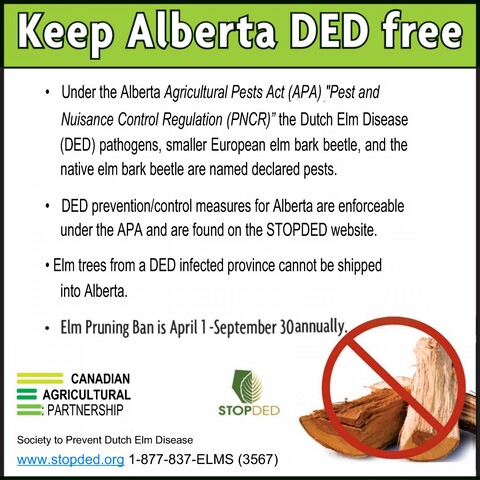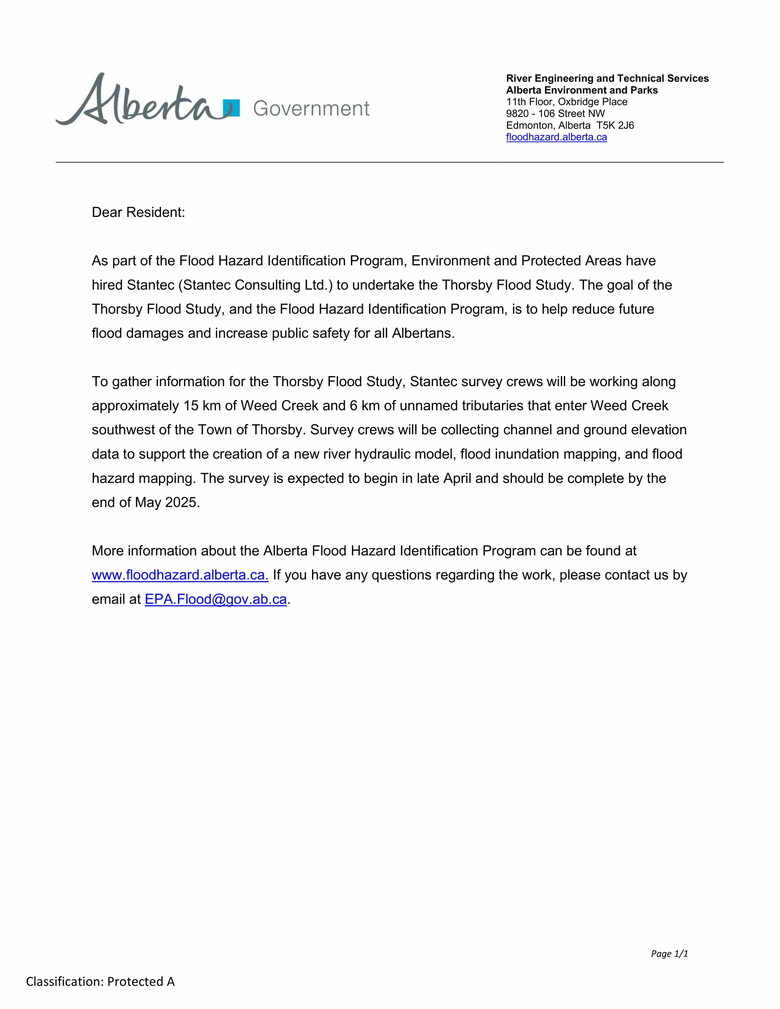...

Dutch Elm Disease Prevention Information
Did you know? Alberta has the largest DED-free stand of American elm in the world. In addition to bringing beauty to communities and adding to our quality of life by providing vital environmental protection, our elm trees are an important agricultural industry. The economic impact of keeping them disease-free is significant.
****
Dutch elm disease – (referred to as DED) is a costly and deadly disease that affects all species of elm trees in Alberta. It is caused by a fungus that clogs the elm tree's water conducting system, causing the tree to die. The fungus is primarily spread from one elm tree to another by 3 beetle species:
- smaller European elm bark beetle (SEEBB) Scolytus multistriatus
- banded elm bark beetle (BEBB) Scolytus schevyrewi
- native elm bark beetle (NEBB) Hylurgopinus rufipes
The beetles are attracted to weak and dying trees, which serve as breeding sites. Once the beetles have pupated and turned into adults, they leave the brood gallery and fly to healthy elms to feed, transporting the fungus on their bodies from one tree to the next.
Under the Alberta Agricultural Pests Act (APA) Pest and Nuisance Control Regulation, both DED pathogens (Ophiostoma ulmi and Ophiostoma nova ulmi) – and the European and native elm bark beetles that carry them – are named declared pests.
****
What can we do to prevent the spread of DED?
- Elm Pruning BAN
- There is an Elm pruning ban period commencing from April 1st and ending on September 30th of the same year.
- Elm bark beetles (EBB), the vectors of DED, are active between these dates and can be attracted to the scent of fresh tree cuts, possibly infecting a healthy tree.
- Elm Preventative Pruning
- Pruning elms can only be carried out from October 1 to March 31 of the following year. Elm trees can be removed any time of the year.
- Preventative pruning is essential to eliminate breeding material for the elm bark beetles (EBB). Preventative pruning is the systematic removal of dead, damaged, or diseased (other than from DED) branches from healthy elm trees. If a tree is dead or dying it should be removed. All elm wood must be properly disposed. Keeping elms well-maintained will aid in the control of DED.
- Improper pruning techniques and tree topping can weaken the elm tree, creating a hazard and increasing the risk of attracting EBBs.
- To avoid spreading DED, all equipment must be sterilized before pruning a different elm tree. To sterilize your tools, use methyl hydrate, a 20% solution of bleach and water, or a 70% concentrate of rubbing alcohol. Note that bleach can rust iron-based tools.
- DED Confirmation
- The presence of the DED must be confirmed by a laboratory test. If a tree is removed before diagnostic testing is complete, the tree must be treated as if it is infested with DED and disposed of according to the guidelines.
- All DED suspect elm trees must be sampled properly and the samples sent to Alberta Agriculture and Forestry's Alberta Plant Health Lab for diagnostic testing. Suspect DED samples are tested at no cost to the sender.
- All samples taken from private trees must be sent to the lab by a Municipality, Agricultural Fieldman, Tree Company or STOPDED. Tree Companies must contact the municipality, Agricultural Fieldman's or STOPDED before sending a sample to the lab. Samples cannot be sent directly by a property owner.
- Once the sample is confirmed to be DED positive, the lab will contact the appropriate contacts for a regulated pest detection.
- Call the STOPDED hotline at 1-877-837-3567 for more instructions.
- Elm Tree Removal
- When an elm tree has tested positive for DED, the tree must be removed immediately and properly disposed of. The stump must also be properly treated. Prompt removal of infected trees is an imperative first step in slowing down the spread of DED. To eliminate EBB breeding material, remove all dead and dying elm trees.
- An elm tree can be removed at any time of year as long as it is immediately disposed of.
- Elm tree removal means to remove the trunk and all other parts of a tree, including the stump.
- Elm Wood Disposal
- Elm wood cannot be stored, or transported unless en route to the closest elm wood disposal site. All elm wood must be properly disposed of immediately by either burning or burying to a minimum depth of 25cm. If elm wood is uninfected with DED, another option is chipping. Immediate disposal of the elm wood ensures the destruction of overwintering beetle larval broods and adults and eliminates EEB breeding material.
- Elm Wood Storage
- Storage of elm wood is prohibited at any time of year unless the wood has been treated as described below:
- All bark has been removed from the wood.
- The wood has been treated by kiln drying it to a moisture content of 18% or less, or heating it to 56C for at least 30 minutes.
- Storage of elm wood is prohibited at any time of year unless the wood has been treated as described below:
- Elm Chipping
- If an elm tree is diagnosed with DED, all wood must be burned or buried. It cannot be chipped.
- Elm wood not infected with DED can be chipped into pieces not more than 5cm. Larger elm wood chips can habor the vector. Fresh chips will give off a scent that will attract the vectors, therefore chips may be destroyed, or stick piled for at least one year before using them in a landscape setting.
- Elm Stump Treatment
- All elm stumps must be properly destroyed. A freshly cut stump with the bark still intact gives off the same scent of a dead or dying tree. The remaining stump from a DED infected tree can also produce infected shoots. Remove the stump to a minimum depth of 10cm below the soil line and fill the hole with soil or treat the elm tree stump in a manner satisfactory to an inspector.
- High Risk Tree
- A high risk tree is defined as a stressed tree that has deteriorated to the point of making it capable of supporting elm bark beetle habitation and breeding. There are many reasons why a tree may become a high risk such as environmental causes or improper pruning such as topping. If an inspector has declared an elm tree to be a high risk, the tree must be removed and properly disposed of.
- Hazard Tree
- Hazard is defined as a branch or a whole tree that is in imminent danger of failing and causing damage or harm to property or people. In the event an elm branch is damaged making it a hazard during the elm pruning ban, corrective pruning can only be done to the hazard branch with inspector approval. A hazard tree can be removed at any time of the year without inspector approval. All elm material must be properly disposed of.
****
This information has been provided courtesy of STOPDED.



